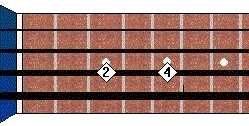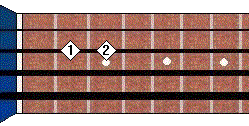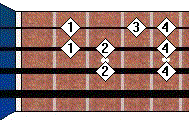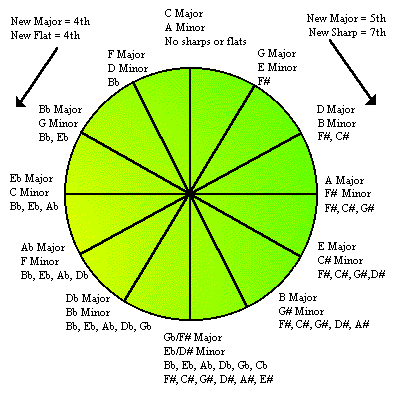Music Theory
Intro to Music Theory
To not know music theory is okay and there's nothing wrong with that. Many successful musicians don't know what a Major is or an eighth note is. However, you better be realistic and understand that a musician that doesn't understand music theory is like a carpenter that doesn't understand building codes and techniques. You can still play using patterns. Usually though, you can get into a rut that you just can't seem to get around. Music theory makes it easier to figure out and understand your opportunities within a song. It also helps to figure out what somebody else is playing and be able to know what to play with them.
When trying to learn a song, you can anticipate where that song will go simply because you understand the rules that guide us all. Don't look at music theory as a boring exercise that can limit you. Don't think that by learning and knowing music theory, it will turn you into a generic player without a unique sound. Think of it as the key that can set you free. A key that opens the door to a vast tool chest of ideas that you build from to develop your own unique sound.
Music theory helps in the communication of a musical idea. Telling the drummer the part goes, "Boom, ba, da, boom, boom...(lots of hand gestures)" or the guitar player "Neer, schwam, eeerrr, doo, doo...(lots of pointing)" . Communication like that is all subjective and rarely accurate in describing the part.
Intervals
Intervals are the relative distance between two notes. There are basically four types of intervals. They all have to deal with how many semitones up or down the neck you move. They are called Major, Minor, Augmented, and Diminished. A semitone is one fret movement on the neck. From fret 1 to fret 2 is a semitone. This is also known as a half step. From fret 1 to fret 3 is a tone or whole step.
Major Intervals

A Major interval is where you move up the neck two semitones. This is also known as a whole step. So if you are in the key of C Major, the next note up from "C" is "D" and "D" is a Major interval up from "C".
Minor Intervals

A Minor interval is where you move up the neck by one semitone. A semitone can also be called a "Half Step". So if you are in the key of C Major, and you are at the note "E", the next note "F" is a Minor interval away from "E".
Augmented Intervals
An Augmented interval is where you move up by one semitone. You typically only ever augment the 4th interval although, you can augment the 6th and 8th intervals. This can be seen when playing the 4th interval of the Locrian Mode.
Diminished Intervals
A Diminished interval is where you move down by one semitone. You only ever augment the 5th interval. This can be seen when playing the 5th interval of the Lydian Mode.
Scales
Scales are a pattern of notes that can be defined by the notes themselves and the semitones and tones between each note.
Chromatic Scales
A chromatic scale consists of 12 notes and basically consists of all the notes from A through to G#. A chromatic climb from the 1st to the 4th or 5th intervals sounds cool. Try as an experiment, have the guitar player start a chromatic scale descending from A on the 3rd string 12th fret to open A. Starting in time with the guitar player, you play the open A and ascend to the 12th fret. The guitar will be descending while you ascend. Try reversing roles.

Diatonic Scales
A diatonic scale is where you use each note only once. Therefore if you play C, you can't also play C# within the same scale. You would have to play it as Db. You also don't have sharps and flats within the same scale. You would have all sharps or all flats.
Major Scales
A major scale is a diatonic scale that is composed of the following major and minor intervals:
1st - 2nd |
2nd - 3rd |
3rd - 4th |
4th - 5th |
5th - 6th |
6th - 7th |
7th - 8th |
|
Notes |
C - D |
D - E |
E - F |
F - G |
G - A |
A - B |
B - C |
Steps |
Whole |
Whole |
Half |
Whole |
Whole |
Whole |
Half |
Interval |
Major |
Major |
Minor |
Major |
Major |
Major |
Minor |
Tones |
Tone |
Tone |
Semitone |
Tone |
Tone |
Tone |
Semitone |
This is a C Major scale. It is composed of the notes, C, D, E, F, G, A, B, and C.


Minor Scales
The A Minor scale uses the same notes as the C Major scale, however, you start at the "A" note. If you played the A Minor scale like you did above with the C Major scale, it would look like this:
A - Tone - B - Semi - Tone - C - Tone - D - Tone - E - Semi-Tone - F - Tone - G - Tone - A
Minor Scale |
1st - 2nd |
2nd - 3rd |
3rd - 4th |
4th - 5th |
5th - 6th |
6th - 7th |
7th - 8th |
|---|---|---|---|---|---|---|---|
Steps |
Whole |
Half |
Whole |
Whole |
Half |
Whole |
Whole |
Interval |
Major |
Minor |
Major |
Major |
Major |
Minor |
Major |
The A Minor scale is made up of the notes A, B, C, D, E, F, G, and A.
![]()
Minor Pentatonic

Circle of Fifths

The circle of fifths was another one of those Gregorian Monk things. Basically what is says is there is a pattern of scales that sound good going from one to the next and if you keep going, eventually you wind up back where you started. When moving in a clock wise motion, you will move in major fifth intervals from one major scale to the next. For instance from the 12 o'clock position of C Major, you move a major 5th to G Major. So from the root note of any major scale, if you move to the major 5th, you will be at the next clock wise scale of the the Circle of Fifths.
Moving in a counter clock wise motion, you will move in fourths. For instance in the case of G Major, the 4th interval is the note C.
The Circle of Fifths works for minor scales as well. Each major interval has a relative minor interval. The relative minor is a 6th interval from the major root note. For instance, the 6th interval of C Major is the note A. Therefore the relative minor of C Major is A Minor. Both scales have the exact same notes you are just starting at two different places in the scale while using the same notes.
Starting from C Major moving clockwise, you will add a new sharp note to each subsequent scale. That new sharp note will always be at the 7th interval. For instance in G major the only sharp is the F# at the 7th interval. The next scale D Major has two sharps, F# and the 7th of D Major which is the note C#. This continues to the 6 o'clock position of the cycle of fifths, F# Major, where there are 6 sharps or Gb Major where there are 6 flats.
From the 1 o'clock position, G Major, to the 5 o'clock position, B Major, all the scales will have sharps in them. From the 7 o'clock position, Db Major, to the 11 o'clock position, F Major, all the scales have flats. The 12 o'clock position, C Major has no sharps or flats and the 6 o'clock position, F# Major and Gb Major, has both sharps and flats.
Modes
Once again those Gregorian Monks are busy at work. Another thing they developed are the eight modes. These guys really had a lot of time on their hands, much to our benefit. When you play modes, you will hear certain modes that scream a particular style of music. Some will sound like rock others will sound Spanish and so on.
A mode is a name given for a scale played at each interval of one particular scale. It really comes down to seven patterns that can be played at each interval and stay in key. Modes are helpful in guiding you to the "legal" notes for a given key. If you are in the key of "C Major" and the guitarist moves to the fourth internal "F", you know you can play the Lydian mode and be in key. The following are the seven different modes.
Ionian - C - Root
C - Tone - D - Tone - E - Semi-Tone - F - Tone - G - Tone - A - Tone - B - Semi-Tone - C
Dorian - D - 2nd Interval
D - Tone - E - Semi-Tone - F - Tone - G - Tone - A - Tone - B - Semi-Tone - C - Tone - D
Phrygian - E - 3rd Interval
E - Semi-Tone - F - Tone - G - Tone - A - Tone - B - Semi-Tone - C - Tone - D - Tone - E
Lydian - F - 4th Interval
F - Tone - G - Tone - A - Tone - B - Semi-Tone - C - Tone - D - Tone - E - Semi-Tone - F
Mixolydian - G - 5th Interval
G - Tone - A - Tone - B - Semi-Tone - C - Tone - D - Tone - E - Semi-Tone - F - Tone - G
Aeolian - A - 6th Interval - Relative Minor
A - Tone - B - Semi-Tone - C - Tone - D - Tone - E - Semi-Tone - F - Tone - G - Tone - A
Locrian - B - 7th Interval
B - Semi-Tone - C - Tone - D - Tone - E - Semi-Tone - F - Tone - G - Tone - A - Tone - B
Reading Music
I'm not going to say that you must be able to read music to be able to play bass, but it does help. If you want to save what you play without having to record it, then writing it down is the only other way. Standard music notation has been around for hundreds of years developed by celibate monks in Europe. For the most part they did a good job and the really neat thing is it is universally understood around the world. There is no Italian music notation or British notation. It's all one and the same.
All you are doing with music notation is indicating what note you are going to play and for how long. It really is that simple. There are other notations that tell you when and how long you don't play anything at all. These are called rests.
You can opt to learn Tabulature (TAB) instead, however, if you are going to go through the effort of learning to read some sort of notation, why not learn the one that works on all instruments, not on only stringed instruments. TAB is not real sophisticated and is very poor at telling you how long notes should be. So, unless you already know the song, you probably won't be able to play it and make it sound correct.
Time Signatures
Time signatures are a way of preparing the musician as to how the song is constructed and what time values each note receives.
A time signature will look like this.  The top number tells the number of counts or beats in a measure. The bottom number tells the kind of note that receives on count or one beat. In the case of 4/4 time, the top "4" indicates that there are four counts or beats per measure and the bottom "4" means that a quarter note receives one count or beat.
The top number tells the number of counts or beats in a measure. The bottom number tells the kind of note that receives on count or one beat. In the case of 4/4 time, the top "4" indicates that there are four counts or beats per measure and the bottom "4" means that a quarter note receives one count or beat.
How to Count In Various Time Signatures
To count in 3/4 time, you would say the following:
1-2-3-2-2-3-3-2-3-4-2-3 and repeat.
To count in 4/4 time you would say the following:
1-2-3-4-2-2-3-4-3-2-3-4-4-2-3-4 and repeat.
To count in 5/4 time you would say the following:
1-2-3-4-5-2-2-3-4-5-3-2-3-4-5-4-2-3-4-5 and repeat.
![]() To count eighth notes, you count as follows:
To count eighth notes, you count as follows:
1-and-2-and-3-and-4-and-2-and-2-and-3-and-4-and-3-and-2-and-3-and-4-and-4-and-2-and-3-and-4-and -- Repeat
To count sixteenth notes, you count as follows:
1-e-and-e-2-e-and-e-3-e-and-e-4-e-and-e -- and repeat
Staff
 All music really is are sounds organized to please the ear, make you uncomfortable, happy, upset, cry, tingle your spine, bang your head or other body appendage, and many other feelings. There is no limit other than the human capacity to feel and express. To organize those sounds, we use the Staff and certain notation. Each sound from the whole can be broken down into two parts. The pitch or tone and the length of time that note or lack of a note exists.
All music really is are sounds organized to please the ear, make you uncomfortable, happy, upset, cry, tingle your spine, bang your head or other body appendage, and many other feelings. There is no limit other than the human capacity to feel and express. To organize those sounds, we use the Staff and certain notation. Each sound from the whole can be broken down into two parts. The pitch or tone and the length of time that note or lack of a note exists.
To indicate what tone to play, we use the staff. The staff is composed of five lines and four spaces. It is a musical chart used to represent the particular notes in a given musical piece. The lines and spaces are always counted from the bottom to the top.
Treble Clef
 This symbol represents the treble clef. Starting from the bottom line of the staff, the notes are E, G, B, D, and F. A memory trick for this is Every Good Boy Does Fine. Starting from the bottom space of the staff the notes are F, A, C, and E. The memory trick for this one is FACE. You can come up with any memory trick to help you remember these.
This symbol represents the treble clef. Starting from the bottom line of the staff, the notes are E, G, B, D, and F. A memory trick for this is Every Good Boy Does Fine. Starting from the bottom space of the staff the notes are F, A, C, and E. The memory trick for this one is FACE. You can come up with any memory trick to help you remember these.
Bass Clef
 This symbol represents the bass clef. Starting from the bottom of line of the staff, the notes are G, B, D, F, and A. or Good Boys Do Fine Always. Starting from the bottom space of the staff, the notes are A, C, E, and G. This one is All Cows Eat Grass.
This symbol represents the bass clef. Starting from the bottom of line of the staff, the notes are G, B, D, F, and A. or Good Boys Do Fine Always. Starting from the bottom space of the staff, the notes are A, C, E, and G. This one is All Cows Eat Grass.
You may have to come up with a memory trick to remember which clef is FACE or which one is ACEG. I use "FACE the top" to remember that FACE is on the treble clef. Anything like that to help you remember. Otherwise, just come back here and look again.
Leger Lines
 Leger lines are additional lines above and below the treble clef and the bass clef. This allows you to show notes that are higher than what can be shown on one clef. This is done when there is no need to show both treble and bass clefs usually for printing considerations to save space on the paper.
Leger lines are additional lines above and below the treble clef and the bass clef. This allows you to show notes that are higher than what can be shown on one clef. This is done when there is no need to show both treble and bass clefs usually for printing considerations to save space on the paper.
If you are using the treble clef, the top line is the note F so the next space up would be G and then the 1st leger line above that would be A. The next space up is B and the 2nd leger line up would be C. The bottom line of the treble clef is E so the space below that would be D and the 1st leger line below that would be C and so on.
Measures
 A
musical piece is separated into measures. Each measure is separated by a bar
line. Often time you will hear a musician refer to a "bar" or "measure", both
mean basically the same thing. The double bar indicates the end of the piece
or final ending of the song. The music doesn't continue past the double bar.
A
musical piece is separated into measures. Each measure is separated by a bar
line. Often time you will hear a musician refer to a "bar" or "measure", both
mean basically the same thing. The double bar indicates the end of the piece
or final ending of the song. The music doesn't continue past the double bar.
Notation
Once you set the stage with the staff so you can indicate what note to play, you now have to have a way to tell the person reading the music for how long should the note last. A note has two basic parts and they are the pitch or tone and the length of time that tone exists.
The type of note indicates the time value of that note. If for instance the time signature is 3/4 or 4/4 the notes in the following table would have the indicated time values:
Note Name | Notation | Count |
|---|---|---|
Thirty-second Note | 1/8 count each | |
Sixteenth Note | 1/4 count each | |
Dotted Sixteenth Note | 3/8 count each | |
Eighth Note | 1/2 count each | |
Dotted Eighth Note | 3/4 count each | |
Quarter Note | 1 count each | |
Dotted Quarter Note | 1 and 1/2 counts each | |
Half Note | 2 counts each | |
Dotted Half Note | 3 counts each | |
Whole Note | 4 counts each |
A dot immediately following a note lengthens the note by one half of the value of the note. So if for instance the half note receives two counts and you have a dotted half note, then that note would receive three counts.
Notes can have their stems turned upward or downward. Notes below the bottom line up to the middle line will usually have their stems turned upward. Notes that are above the top line down to the middle line will usually have their stems turned downward. There is no special significance to the orientation of the stems and is only for the purpose of printing and ease of reading.
Rests
Rest notes are used to indicate that no notes are to be played for the period of time defined by the particular rest notation. For instance, a quarter rest indicates you should not play anything for a count of one. As with the notes notation, a dot immediately after a rest indicates you lengthen the rest by one half of the rest's value.
If the time signature is 4/4, the following rests would have the values indicated in the following table:
Rest Name | Notation | Count |
|---|---|---|
Thirty-second Rest |  | 1/8 count each |
Sixteenth Rest |  | 1/4 count each |
Eighth Rest |  | 1/2 count each |
Quarter Rest |  | 1 count each |
Half Measure Rest |  | 2 counts each |
Full Measure Rest |  | 4 counts each |
Sharps
A sharp indicated by the notation  indicates that you increase the pitch of the note immediately afterward by one semi-tone. Usually you will see this notation by the bass clef as an indication of the key. You may also see it next to a single note indicating that note is sharp and further instances of that note within the measure is also sharp. Some times you may see a double sharp as indicated by two sharp notations prior to the note. This simply means you increase the pitch by two semi-tones. As described earlier, a semi-tone is one half step or in other words one fret closer to the body of the bass.
indicates that you increase the pitch of the note immediately afterward by one semi-tone. Usually you will see this notation by the bass clef as an indication of the key. You may also see it next to a single note indicating that note is sharp and further instances of that note within the measure is also sharp. Some times you may see a double sharp as indicated by two sharp notations prior to the note. This simply means you increase the pitch by two semi-tones. As described earlier, a semi-tone is one half step or in other words one fret closer to the body of the bass.
Flats
A flat indicated by the notation  indicates that the note immediately afterward is reduced in pitch by one semi-tone or in other words one fret away from the body of the bass. You will usually see this notation by the bass clef indicating the key. You may see it next to a single note indicating that note is flat and further instances of that note within the measure is also sharp. Some times you may see a double flat as indicated by two flat notations prior to the note. This simply means you decrease the pitch by two semi-tones.
indicates that the note immediately afterward is reduced in pitch by one semi-tone or in other words one fret away from the body of the bass. You will usually see this notation by the bass clef indicating the key. You may see it next to a single note indicating that note is flat and further instances of that note within the measure is also sharp. Some times you may see a double flat as indicated by two flat notations prior to the note. This simply means you decrease the pitch by two semi-tones.
Naturals
Naturals are indicated by the notation  and
indicate that the note immediately afterward is not sharp or flat as indicated
by the key or by a previous flat or sharp notation. For instance if the note
is "A#", then you play "A" for the rest of the measure or until you see a flat
or sharp notation for that particular note. Another name for Naturals are Accidentals
because they are basically sharps or flats that are not part of the key signature
and are only in effect for the measure in which they are placed.
and
indicate that the note immediately afterward is not sharp or flat as indicated
by the key or by a previous flat or sharp notation. For instance if the note
is "A#", then you play "A" for the rest of the measure or until you see a flat
or sharp notation for that particular note. Another name for Naturals are Accidentals
because they are basically sharps or flats that are not part of the key signature
and are only in effect for the measure in which they are placed.
Ties
Ties are used to litterly tie two notes together. You will see them tie two different notes indicating a slide up or down depending on if the first note is higher or lower than the second note. A tie is also used for notes that cross bar lines. If you have a half note that falls on the fourth beat of the measure, it will represented by quarter note on the left side of the bar with a tie to a quarter note on the right side of the bar.
Repeat Dots
Legato and Slur
Ritardando
Gradually slowing the tempo or speed. Usually shown as the abbreviation "ritard." or "rit."
A Tempo
This indicates that you should return to the normal tempo of the song. You will usually see this after a Ritardando.
